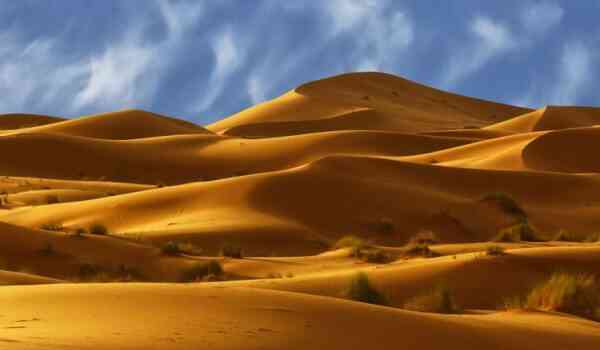The vast Sahara desert has become synonymous with a hot, barren place where there is no life. In fact, this is not so – an interesting local ecosystem has long been able to adapt to existence in such extreme conditions, although, of course, it is not easy for a person to survive here. However, people also live in the Sahara, but an unprepared person will definitely not last long in these inhospitable lands.
Interesting facts about the Sahara desert
- In terms of area, it is approximately equal to half the area of Russia or the entire area of Brazil.
- The Sahara desert accounts for about 30% of the entire area of Africa.
- Contrary to popular belief, the Sahara Desert is not the largest on Earth – the palm belongs to the Antarctic Desert. But among the usual deserts with sand, heat and dunes, the Sahara takes exactly the first place (interesting facts about deserts).
- Every year the Sahara wins more and more space for itself. It expands to the south, moving 5-10 km annually.
- People live around the oases in the Sahara.
- There are as many rocky areas as those covered with sand.
- Name «Sahara» comes from a consonant Arabic word, which in translation simply means «desert».
- Rich deposits of gas and oil have been discovered on its territory.
- Among the hot deserts, the Sahara is not the driest. It rains here, albeit vanishingly rarely, but in the Chilean Atacama Desert they have not been for about 400 years (interesting facts about the Atacama Desert).
- The highest peak in the Sahara is Emi Koussi, rising 3.4 km above sea level.
- Partly on its territory there are 9 states plus one unrecognized, called Western Sahara.
- The height of the sand dunes in the Sahara desert can reach 160-180 meters. That’s taller than a 70-story building.
- It snowed in the Sahara in 1879 and 2012. True, it melted immediately.
- Disappearingly rare here are powerful rains that last for several days.
- About 500 different plant species grow in the seemingly so lifeless territory of the Sahara.
- The only river that constantly flows through the borders of the Sahara is the mighty Nile (interesting facts about the Nile River).
- In total, about 2 million people live in the Sahara, mostly Berbers and Tuareg.
- Most of the oases here arise in places where water from underwater rivers breaks through to the surface.
- Scientists have established that these regions turned into a desert about 5 million years ago, but the Sahara finally took on its modern appearance about 10,000 years ago.
- About another 6,000 years rivers flowed through it, but now all of them, except for the Nile, have dried up.
- Every year, powerful winds bring down clouds full of sand raised in the Sahara on the African island country of Cape Verde, creating many inconveniences for the locals (interesting facts about Cape Verde).
- In the very center of the Sahara, archaeologists have discovered ancient rock paintings that testify that primitive people once lived in these parts.
- There are permanent lakes in the Sahara, for example, Unianga and Ubari.
- The highest temperature ever recorded in the Sahara was +57.8 degrees. At the same time, the surface here sometimes heats up to +80 degrees.
- In total, about 4,000 species of living creatures live here.
- In the central part of the Sahara, it rains every few years.
- In the Sahara, under the influence of southern winds, monstrous sandstorms arise, which then fall on the surrounding countries and sometimes rage for several days (interesting facts about sandstorms).
- In most parts of the Sahara, heavy dew falls in the morning.
- In the local mountain ranges, frosts occur at night, and the air temperature drops to -18 degrees.
- In some parts of the Sahara, the average daily temperature exceeds +40 degrees. However, it is usually quite cold here at night.
- It snows almost every year on the northern plateaus of the Sahara.
- In medieval times, trading caravans passed through it, the largest of which, according to evidence Arab historians, consisted of almost 12,000 camels.
